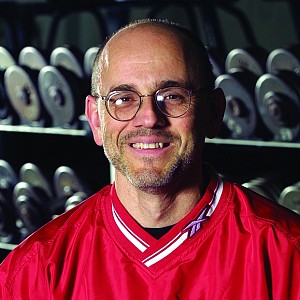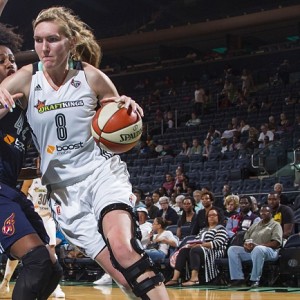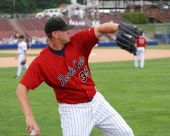The Rotator Cuff
Aug 2, 2010 John
The Rotator Cuff
Strategies for a Healthy Cuff
John Pallof, PT, OCS, COMT, CSCS
The rotator cuff is an often misunderstood, yet very important muscle group within the shoulder complex. It is a crucial piece of the puzzle when training for a well functioning shoulder complex, along with the other mobility, flexibility, and scapular stabilizer function concerns. The purpose of this article is to develop an understanding of what the rotator cuff’s functions are, what types of dysfunction the cuff is susceptible to, training strategies for a healthy cuff, and how to train around pathology.
The Anatomy
The rotator cuff is composed of four individual muscles – the infraspinatus, supraspinatus, teres minor, and the subscapularis. Their origin is on the scapula, and all insert on the humerus in various spots around the humeral head.

The Rotator Cuff

Glenohumeral Joint Capsule/Rotator Cuff Tendons

Passive Support Structures of the Shoulder Complex
The most important anatomical feature of the rotator cuff (in my opinion at least) is the fact that the tendons of the different muscles of the rotator cuff are fused to the glenohumeral joint capsule in various areas. This is crucial - as tension develops through the tendons with contraction, it lends tension to the ligamentous tissues of the glenohumeral joint capsule. This gives the “passive” stabilizing structures of the glenohumeral joint significant structural rigidity!!
Another important anatomical consideration is the fact that the capillary supply through the distal supraspinatus tendon is very irregular. It tends to be unevenly distributed due to the repetitive “milking” type stresses the tendon is exposed to due to the restricted nature of the subacromial space, especially with activities requiring elevation/abduction. This can lead to poor tissue quality susceptible to failure/dysfunction.
Last – don’t forget that you are actually dealing with four joints in the shoulder complex – not just one! Acromioclavicular, sternoclavicular, glenohumeral, and scapulothoracic joints.
Rotator Cuff Function
The rotator cuff has several jobs that are important to proper functioning of the shoulder complex. First – as I had mentioned above, it plays a very important role in generating stability for the glenohumeral joint via its extensive connections to the joint capsule. When the rotator cuff fires it lends a significant amount of structural rigidity to the joint capsule due to the fact its tendons are fused to the capsular tissue. This action also plays a role in the next important function of the cuff – controlling the arthrokinematics of the GH joint.
When moving the GH complex through an arc of motion in any direction, the humeral head rolls, spins, and glides within the glenoid fossa. There is a prescribed manner in which this happens in order to maintain normal function, especially preserving the subacromial space in order to avoid impingement. Healthy cuff functioning is crucial for this to occur.
Third – the cuff acts as an antagonist, or counterforce for the larger muscles which insert onto the humerus – i.e. pec major, deltoids, teres major, latissimus, etc. When these larger muscle groups fire, the cuff needs to be active in order to counteract the effect on glenohumeral arthrokinematics that the larger muscles exert. This force coupling is what allows for a shoulder complex that functions in an efficient, powerful manner.
Pathology
The intent of this article is to give some insight as to what the rotator cuff is, what it does, and how to influence rotator cuff function through exercise/programming. However, it is important to understand that the cuff can function in a pain free, healthy manner even in the presence of pathology!! If you address soft tissue quality and length, cuff strength/endurance, scapular stability and strength, and posture, the chances of a well functioning shoulder are significantly improved. I’m not suggesting that surgery is never necessary, because sometimes it is, regardless of what you do. However, you may be surprised by the number of people with some sort of cuff pathology who never know it – because its not symptomatic.
If you suspect some sort of pathology, it would be wise to refer your client to a qualified health professional – whether it be a good physician, a skilled PT, etc. Don’t try to be a hero and handle it entirely on your own if you aren’t capable – remember – your job is to help your client get healthy – that can mean steering them in the right direction sometimes if you cannot provide them what they need.
Exercise Principles
First – remember, the rotator cuff muscles have the same physiology as any other muscle – so when training it, similar principles should be applied. Varying loads, set and rep schemes, and frequency must all be taken into account. You should program to improve cuff endurance, strength, and tissue quality (through rest/controlling frequency and soft tissue work). Some general guidelines:
- Soft tissue work is a must – preferably administered by a clinician, whether athletic trainer, physical therapist, chiropractor, or massage therapist. However, self soft tissue work with a lacrosse ball, baseball, etc. is helpful. Areas that I find to be problematic: the belly of the infraspinatus, subscapularis (can only be treated manually for obvious reasons), teres minor (esp in throwers). While I know they aren’t cuff muscles specifically: teres major, the latissimus between its insertions on the medial angle of the scap and the humerus (this is a big problem spot – tends to develop a length restriction), and the pectoralis major. Self soft tissue work to the teres group and infraspinatus is very helpful, and should be taught in limited bouts (no more than three minutes up to twice a day).
- Most people with dysfunction (or no dysfunction for that matter) are significantly weak through their posterior cuff – their external rotators. This is because of how internal rotator dominant we are/our exercises are, and how much our generally crappy posture puts these muscles in a poor position to work effectively. So it is appropriate at times to skew your volumes towards external rotator work.
- Vary rep ranges and loads! While I’m not advocating foolishly loading cuff exercises, don’t be afraid to increase the resistance to the higher end of the spectrum as to what the client can do with perfect form. These muscles need to be both fatigue resistant and able to produce peaks of force in order to function effectively. I will generally prescribe three to four sets, with rep ranges between six to twelve. Sometimes two by fifteen. At times for a rehab type situation I prefer to prescribe very low volume performed more frequently to maintain good motor patterns in the presence of pathology or injury.
- Vary movement types – choose different exercises – some allowing for a stable scap, and others that emphasize scapulohumeral rhythm – i.e – some allow the scap to move, others require good stabilizer endurance to maintain it in a good position while the cuff works. It is essential to teach the cuff how to function in a dynamic situation, where the glenoid and humeral head are moving through space.
- Don’t overdo it!!! Two days a week of cuff work should be more than adequate. These are small muscle groups, and can be overtrained. If it is a throwing athlete, perhaps the two days a week plus one or two other cuff exercises supersetted into other workouts. Hearing three sets of ten every day makes me want to vomit in my mouth. Even in a post surgery situation, no more than three to four days a week are warranted.
- Do them when you are fresh – i.e., at the beginning of your workout. Quality is an absolute must here – no crap form!!!
The pull series has three movements: external rotation in abduction (focus on static scap positioning, keeping humerus in place; resistance from low angle); horizontal abduction (keep humerus elevated, maintain vertical forearm to create IR torque; be sure to move scap with humerus; again, resistance from low angle); and elbow flexion (arm elevated, humerus behind scapular plane, deep scaps depressed and retracted).
The Push Series also has three movements: internal rotation (scaps static, keep humerus elevated, resistance from downward angle); horizontal adduction (keep humerus elevated, forearm vertical to create external rotation torque, allow scap to move with humerus); and elbow extension (scaps back/down, arm slightly horizontally abducted).
Sidelying Dumbell External Rotation
Sidelying Dumbell Arm Lowering
Seated Cable External Rotation: Resistance on upward angle; humerus in scapular plane; rapid concentric phase, controlled eccentric; keep scaps static down and back.
Seated Cable Internal Rotation: resistance on downward angle, humerus in scapular plane.
Scarecrow Stretch for internal rotation in abduction: key is to cue athlete only to "visit the endrange" of IR, NOT looking for strong stretching sensation.
Sidelying Internal Rotation Stretch (in flexion): make sure scaps are set back, and are perpendicular to the floor; elbow slightly below shoulder height; only "visiting the endrange", not looking for large stretch sensation.
A quick note about internal rotation: if someone is lacking it, pay particular attention to it, and give it remedial attention. If not, just make sure they maintain it - maybe stretch for shorter duration, and less frequently - maybe a few reps a week.
Rotator cuff work should be a part of anyone's routine, whether healthy or not - an ounce of prevention is worth a pound of cure. And you will likely be surprised by how weak, and/or easily fatigued most people's rotator cuffs are. They can all use the work, whether healthy, injured, young, old, ahtletic or not.



